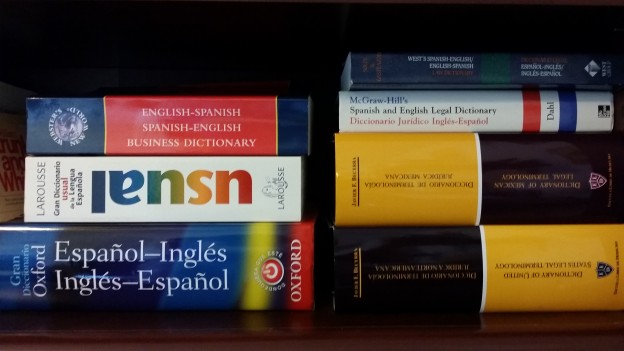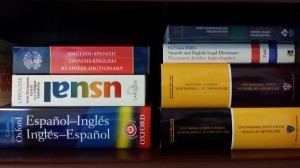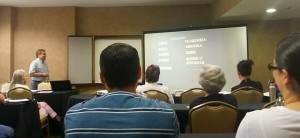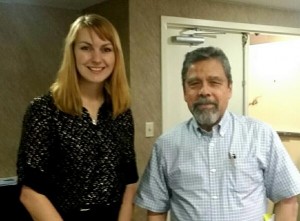Each year, Mexico City’s Escuela Libre de Derecho announces a law-school elective course inconspicuously titled “Legal English Workshop.” Now approaching its twenty-fifth year, the course is still taught by attorney, professor, and author Javier F. Becerra. The professor has written two legal dictionaries, the Dictionary of United States Legal Terminology (with Spanish explanations) and the Dictionary of Mexican Legal Terminology (with English explanations), each more than 1,000 pages, that are prized assets in many legal translators’ collections.
The Walking Dictionary
To understand Becerra’s dictionaries, however, we must leave the professor at his lectern for a moment and find him as a young Mexican lawyer, recently returned from two years in England as a Trinity College research student at Cambridge University where he had written a thesis on comparative law, to work at a prestigious law firm in Mexico City. He was working with the firm’s senior partners on cross-border transactions and international mergers and acquisitions, but word got around that he had studied abroad and had mastered the language of the law in English. His colleagues would stop him in the hall about English terms on so many subjects that he was forced to expand his comparative law research into many areas of the law. “They saw me as a walking dictionary,” he says with a laugh. Becerra began jotting down the words and phrases that came up and, later, he added brief explanations for his own benefit.
Becerra’s assistant, Malú, organized his notes alphabetically, and they turned into glossaries. “The work on the glossaries was constant and automatic as I noted down what was discussed in those conversations.” There were no computers, so the glossaries were typewritten at first. Later, they were updated on word processors, and finally, computers. This went on for twenty-five years.
Legal Translation in the Field
Becerra’s legal work at the law firm always overlapped with translation.
“Ninety percent of the firm’s clients were large multinational companies from the United States,” he explains. The companies wanted to do business in Mexico, but weren’t aware of how things worked there. “Generally, they would try to replicate their policies and procedures from the United States. But we had to make adaptations and help the clients understand that certain things simply don’t work in Mexico, or they work differently.”
His clients’ business areas, legal departments and outside counsel would send a variety of legal documents and contracts in English, and Becerra first had to prepare a Spanish version that was then localized to conform to Mexican laws and regulations, business norms and, most importantly, local drafting technique. Later, the Spanish version had to be translated back to English for further review by and comments from the client until a final bilingual version was acceptable to all parties. This was a long and difficult process but a necessary one to prevent unnecessary legal problems down the road. At first, the firm’s translation department prepared draft translations, but Becerra concluded that the drafts were often too literal to be useful.
“The main idea for the translator is first to understand and then communicate the same concept as the original, independently of the words.”
At the beginning, Becerra found it more efficient to do it himself and start from scratch rather than spend valuable time identifying errors and editing translations. He worked closely with the firm’s translators to teach them his method and required them to study and learn the nuances of legal vocabulary. He ended up heading the firm’s translation department. Despite this facet of his work, Becerra has never considered himself a translator.
“What I have done with translation is all derived from my work as an attorney. Most of the time, my work was fully bilingual. The transactions I was involved with were typically negotiated in English but had to be committed to writing in both languages for the parties to understand each other. What I had to do was to write and negotiate legal documents and contracts in such a way so as to make sure that they would work and be enforceable in Mexico and, at the same time, satisfy the foreign client and its U.S. legal counsel that the business objectives were adequately covered even though the legal terms and drafting style would not coincide with those of the U.S. legal system. Thus, language and translation were always tools, not an end unto themselves.”
Teaching and Going to Press
In 1989, a group of legal interpreters and translators contacted Becerra for help developing correct legal vocabulary. He inaugurated the Legal English Workshop and convinced the Escuela Libre de Derecho to open enrollment to non-students so the interpreters and translators could attend. The course was a hit, and repeat students meant Becerra had to develop new course materials every year. His glossaries continued to grow and as a result, a variety of areas of the law were studied and discussed.
Once he decided to publish a dictionary, he entered a five-year period of intense editorial work to prepare his Spanish-English glossary for publication.
“What I had were two big lists; one with words and phrases from Spanish to English, and the other from English to Spanish. Although no one had taught me lexicography, I realized that translating words was not enough. Synonyms, conceptual descriptions, short explanations, and usage examples were required for the reader to understand and translate unfamiliar concepts. I used Black’s Law Dictionary as a guide to start shaping the first dictionary. In addition, I should mention that for that endeavor, I was fortunate enough to have the manuscript reviewed by George Humphrey, a U.S. lawyer who is now a partner of a large Houston law firm. In later years I enlisted the collaboration of John Young, a diligent Canadian who is a lawyer both in Mexico and Canada, and who made valuable corrections, suggestions and contributions for the second edition of that dictionary.”
Becerra notes that a common misconception, especially among non-translators, is that any legal term used in any Spanish-speaking country will be universally valid in all other Spanish-speaking countries. Despite common roots and a common language, legal concepts don’t always cross borders.
“Legal systems are like a tree. There is a common trunk but as it grows, the branches are not the same. Some of them might look similar, but others are totally different, even in the same language. So to make a correct translation, one must compare the legal language of two clearly identified countries.”
As a result, Becerra focused his dictionaries exclusively on the legal contexts of the United States and Mexico. “The law exists to address the unique problems in a certain place. Since the ideas aren’t the same from place to place, the law and its language change. Legal language is local, not universal.”
As an example, he points to the term “living will,” a concept that appears in many Spanish-speaking countries but with different legal nuances and names. “There are websites where translators have spent months trying to agree on a single definitive Spanish translation, which is a futile exercise because there isn’t one. It’s not like a technical dictionary, where a term points to a specific object.”
Even with material restricted to the U.S. and Mexican judicial systems, the dictionaries require constant updating as laws evolve.
“With the first dictionary, the typesetter was ready to format the dictionary for print, but I kept making changes. There were four versions of the manuscript before we had the final one. Needless to say, he was very annoyed and the working relationship became rather stressful for both. When it was time to publish the second dictionary, we went through five versions, but that time around the typesetter and I got along much better, since we knew what to expect from each other.” It took three more years to edit the second edition of the Dictionary of Mexican Legal Terminology and, now, it is time to update the Dictionary of United States Legal Terminology.
Dictionary for a New Era
Becerra is now preparing a pilot program for the English-Spanish dictionary to test his idea to offer the new edition digitally. There are several reasons behind this shift away from print.
“It’s much easier to update an online version. And the print dictionaries are enormous, but I’ve met people who carry both of them around. Frankly, it’s inconvenient. Now, with the technology we have, people are more accustomed to carrying an iPad.”
He clarifies that the digital edition would not be a simple e-book converted from the print dictionary. Although the details are still in development, the idea is to offer a service allowing online consultations and monthly updates to keep up with legislative reforms and other changes.
I ask about the team working on the updated content, and Becerra laughs. “Team? My team is Malú and me.” He sets down his cup of herbal tea. “Let me see if I have a page marked up with corrections.”
He calls Malú, the same smiling assistant who has helped him not only with his everyday legal work, but also to write the dictionaries for 33 years. She appears with a stack of papers so tall it would be dangerous to move it with one hand. Becerra introduces her, then begins flipping through the manuscript, pulling out pages to show me. He holds up one printout after another.
“The highlighted entries are new,” he says, pointing. At least half the page is highlighted. “You can also see notes for entries that still need to be incorporated.” There are asterisks leading to handwritten notes at the bottom of the page which continue onto the back. He unfolds a yellow paper taped to the bottom of the page, showing even more comments on both sides.
He is visibly excited about the newest iteration of his lifelong project. “The first edition of the first dictionary was thirty years in the making. The first edition of the second took eight years. The second edition of the first dictionary took three years. Now I’ve spent three years on new material for this edition, and, with an online format, I will be able to update it more rapidly.”
More information:
——-
Javier F. Beccera, having retired from private practice after more than forty years at the law firm, including a three-year stint as a managing partner, is now fully dedicated to his dictionaries, to his teaching career as a legal English professor, and as an invited speaker at many conferences, both in his home country and in United States, apart from his long-life photography hobby. He has two beautiful daughters, Gaby and Sofia.





Hi Holly,
Great interview. As I told you, it was high time somebody talked to Mr. Becerra and published an article on it. His dictionary is key in legal English-Spanish lexicography.
BTW, do you happen to know if Becerra’s dictionary will go fully digital? I mean, will this entail that the paper edition will vanish into thin air?
Regards, and thank you for this great interview,
Mariano Vitetta
Hi Mariano,
Thanks for your comment and excellent question. I passed it along to Professor Becerra and he replied that the digital version is still a long way from publication and that, thus far, there has been no discussion of eliminating the print version.
Warm regards from Texas,
Holly
Where can I find the digital version of the Spanish – English Legal Dictionary by Javier Becerra?
Hi Michelle, sorry it took me so long to see and approve your comment. I am still getting a handle on spam controls. You can find the dictionary at https://diccionariojfbecerra.com